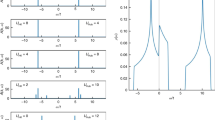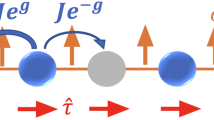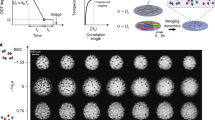Abstract
Indistinguishable particles in two dimensions can be characterized by anyonic quantum statistics, which is more general than that of bosons or fermions. Anyons emerge as quasiparticles in fractional quantum Hall states and in certain frustrated quantum magnets. Quantum liquids of anyons show degenerate ground states, where the degeneracy depends on the topology of the underlying surface. Here, we present a new type of continuous quantum phase transition in such anyonic quantum liquids, which is driven by quantum fluctuations of the topology. The critical state connecting two anyonic liquids on surfaces with different topologies is reminiscent of the notion of a ‘quantum foam’ with fluctuations on all length scales. This exotic quantum phase transition arises in a microscopic model of interacting anyons for which we present an exact solution in a linear geometry. We introduce an intuitive physical picture of this model that unifies string nets and loop gases, and provide a simple description of topological quantum phases and their phase transitions.
This is a preview of subscription content, access via your institution
Access options
Subscribe to this journal
Receive 12 print issues and online access
$209.00 per year
only $17.42 per issue
Buy this article
- Purchase on Springer Link
- Instant access to full article PDF
Prices may be subject to local taxes which are calculated during checkout








Similar content being viewed by others
References
Wen, X.-G. Vacuum degeneracy of chiral spin states in compactified space. Phys. Rev. B 40, 7387–7390 (1989).
Laughlin, R. B. Anomalous quantum Hall effect: An incompressible quantum fluid with fractionally charged excitations. Phys. Rev. Lett. 50, 1395–1398 (1983).
Wen, X.-G. & Niu, Q. Ground-state degeneracy of the fractional quantum Hall states in the presence of a random potential and on high-genus Riemann surfaces. Phys. Rev. B 41, 9377–9396 (1990).
Moessner, R. & Sondhi, S. L. Resonating valence bond phase in the triangular lattice quantum dimer model. Phys. Rev. Lett. 86, 1881–1884 (2001).
Balents, L., Fisher, M. P. A. & Girvin, S. M. Fractionalization in an easy-axis Kagome antiferromagnet. Phys. Rev. B 65, 224412 (2002).
Ioffe, L. B. et al. Topologically protected quantum bits using Josephson junction arrays. Nature 415, 503–506 (2002).
Levin, M. & Wen, X.-G. String-net condensation: A physical mechanism for topological phases. Phys. Rev. B 71, 045110 (2005).
Kitaev, A. Fault-tolerant quantum computation by anyons. Ann. Phys. 303, 2–30 (2003).
Kitaev, A. Anyons in an exactly solved model and beyond. Ann. Phys. 321, 2–111 (2006).
Jackeli, G. & Khaliullin, G. Mott insulators in the strong spin–orbit coupling limit: From Heisenberg to a quantum compass and Kitaev models. Phys. Rev. Lett. 102, 017205 (2009).
Kim, B. J. et al. Phase-sensitive observation of a spin-orbital Mott state in Sr2IrO4 . Science 323, 1329–1332 (2009).
Leinaas, J. M. & Myrheim, J. On the theory of identical particles. Il Nuovo Cimento 37, 1–23 (1977).
Bouwknegt, P. & Schoutens, K. Exclusion statistics in conformal field theory—generalized fermions and spinons for level-1 WZW theories. Nucl. Phys. B 547, 501–537 (1999).
Read, N. & Rezayi, E. Beyond paired quantum Hall states: Parafermions and incompressible states in the first excited Landau level. Phys. Rev. B 59, 8084–8092 (1999).
Slingerland, J. K. & Bais, F. A. Quantum groups and non-Abelian braiding in quantum Hall systems. Nucl. Phys. B 612, 229–290 (2001).
Büchler, H. P., Micheli, A. & Zoller, P. Three-body interactions with cold polar molecules. Nature Phys. 3, 726–731 (2007).
Fendley, P. Topological order from quantum loops and nets. Ann. Phys. 323, 3113–3136 (2008).
Wheeler, J. A. Geons. Phys. Rev. 97, 511–536 (1955).
Wheeler, J. A. On the nature of quantum geometrodynamics. Ann. Phys. 2, 604–614 (1957).
Friedan, D., Qiu, Z. & Shenker, S. Conformal invariance, unitarity, and critical exponents in two dimensions. Phys. Rev. Lett. 52, 1575–1578 (1985).
Cappelli, A., Itzykson, C. & Zuber, J. B. Modular invariant partition functions in two dimensions. Nucl. Phys. B 280, 445–465 (1987).
Pasquier, V. Lattice derivation of modular invariant partition functions on the torus. J. Phys. A 20, L1229–L1238 (1987).
Pasquier, V. Two-dimensional critical systems labelled by Dynkin diagrams. Nucl. Phys. B 285, 162–172 (1987).
Temperley, N. & Lieb, E. Relations between percolation and colouring problem and other graph-theoretical problems associated with regular planar lattices—some exact results for percolation problem. Proc. R. Soc. Lond. A 322, 251–280 (1971).
Feiguin, A. et al. Interacting anyons in topological quantum liquids: The golden chain. Phys. Rev. Lett. 98, 160409 (2007).
Gils, C. et al. Collective states of interacting anyons, edge states, and the nucleation of topological liquids. Phys. Rev. Lett. 103, 070401 (2009).
Haldane, F. D. M. ‘Fractional statistics’ in arbitary dimensions: A generalization of the Pauli principle. Phys. Rev. Lett. 67, 937–940 (1991).
Freedman, M., Nayak, C. & Shtengel, K. Extended Hubbard model with ring exchange: A route to a non-Abelian topological phase. Phys. Rev. Lett. 94, 066401 (2005).
Fradkin, E. & Shenker, S. H. Phase diagrams of lattice gauge theories with Higgs fields. Phys. Rev. D 19, 3682–3697 (1979).
Trebst, S., Werner, P., Troyer, M., Shtengel, K. & Nayak, C. Breakdown of a topological phase: Quantum phase transition in a loop gas with tension. Phys. Rev. Lett. 98, 070602 (2007).
Fendley, P. & Fradkin, E. Realizing non-Abelian statistics in time-reversal-invariant systems. Phys. Rev. B 72, 024412 (2005).
Freedman, M., Nayak, C., Shtengel, K., Walker, K. & Wang, Z. A class of P,T-invariant topological phases of interacting electrons. Ann. Phys. 310, 428–492 (2004).
Greenblatt, R. L., Aizenman, M. & Lebowitz, J. L. Rounding of first order transitions in low-dimensional quantum systems with quenched disorder. Preprint at <http://arxiv.org/abs/0907.2419v1> (2009).
Moore, G. & Seiberg, N. Classical and quantum conformal field theory. Commun. Math. Phys. 123, 177–254 (1989).
Kirillov, A. N. & Reshetikhin, N. Yu. Infinite Dimensional Lie Algebras and Groups (ed. Kac, V. G., World Scientific, 1988).
Albuquerque, A. F. et al. The ALPS project release 1.3: Open-source software for strongly correlated systems. J. Magn. Magn. Mater. 310, 1187–1193 (2007).
Acknowledgements
We thank M. Freedman, X.-G. Wen and P. Fendley for stimulating discussions. Our numerical simulations were based on the ALPS libraries36. A.W.W.L. was supported, in part, by NSF DMR-0706140.
Author information
Authors and Affiliations
Contributions
C.G., S.T. and M.T. contributed to the numerical work. C.G., A.K., A.W.W.L and Z.W. contributed to the analytical solution. All authors contributed to the development of the general picture presented in this manuscript.
Corresponding author
Supplementary information
Supplementary Information
Supplementary Information (PDF 500 kb)
Rights and permissions
About this article
Cite this article
Gils, C., Trebst, S., Kitaev, A. et al. Topology-driven quantum phase transitions in time-reversal-invariant anyonic quantum liquids. Nature Phys 5, 834–839 (2009). https://doi.org/10.1038/nphys1396
Received:
Accepted:
Published:
Issue Date:
DOI: https://doi.org/10.1038/nphys1396
This article is cited by
-
Chain of interacting SU(2)4 anyons and quantum SU(2) k × $\overline {SU(2)_k } $ doubles
Theoretical and Mathematical Physics (2011)
-
Wormholes in quantum matter
Nature Physics (2009)



